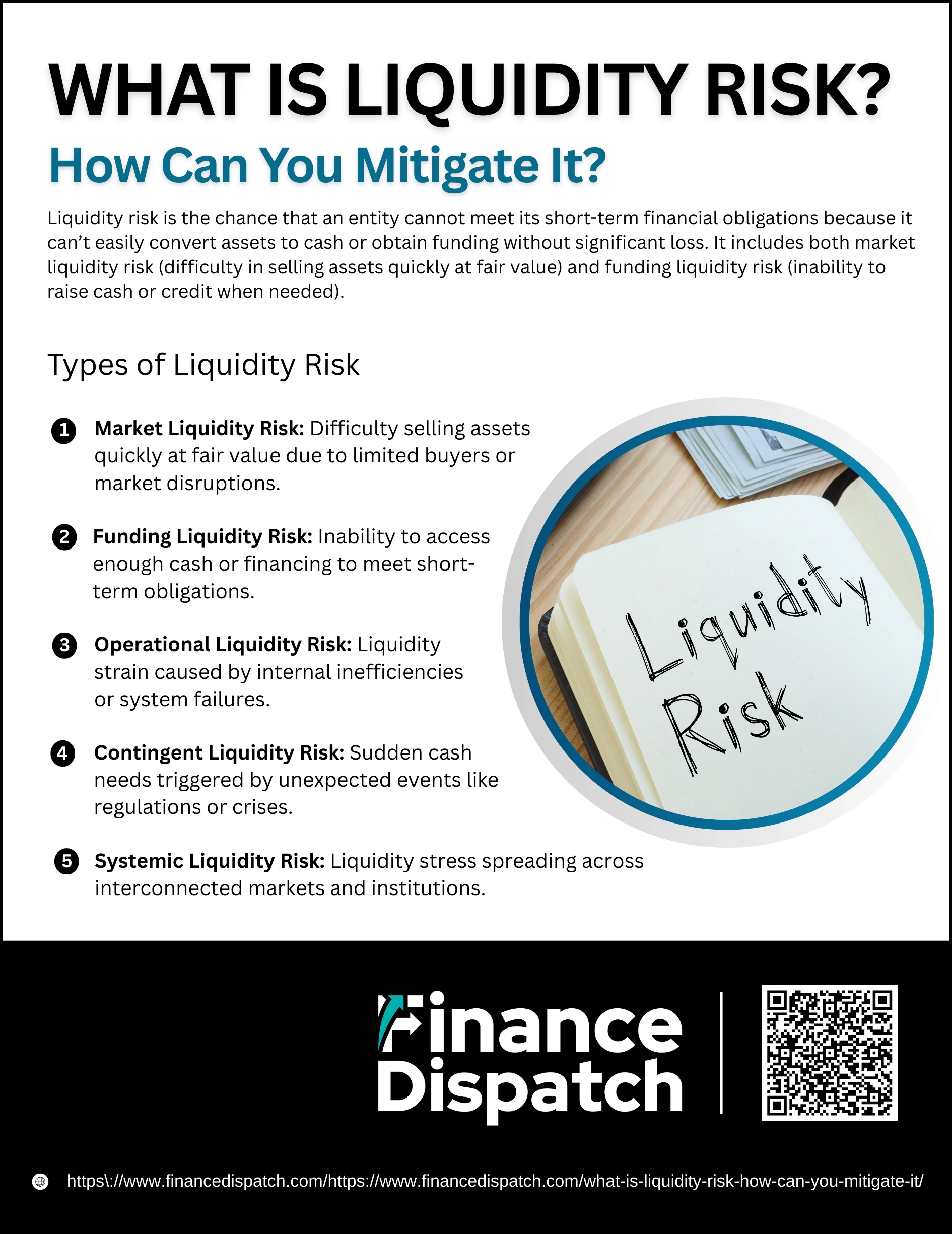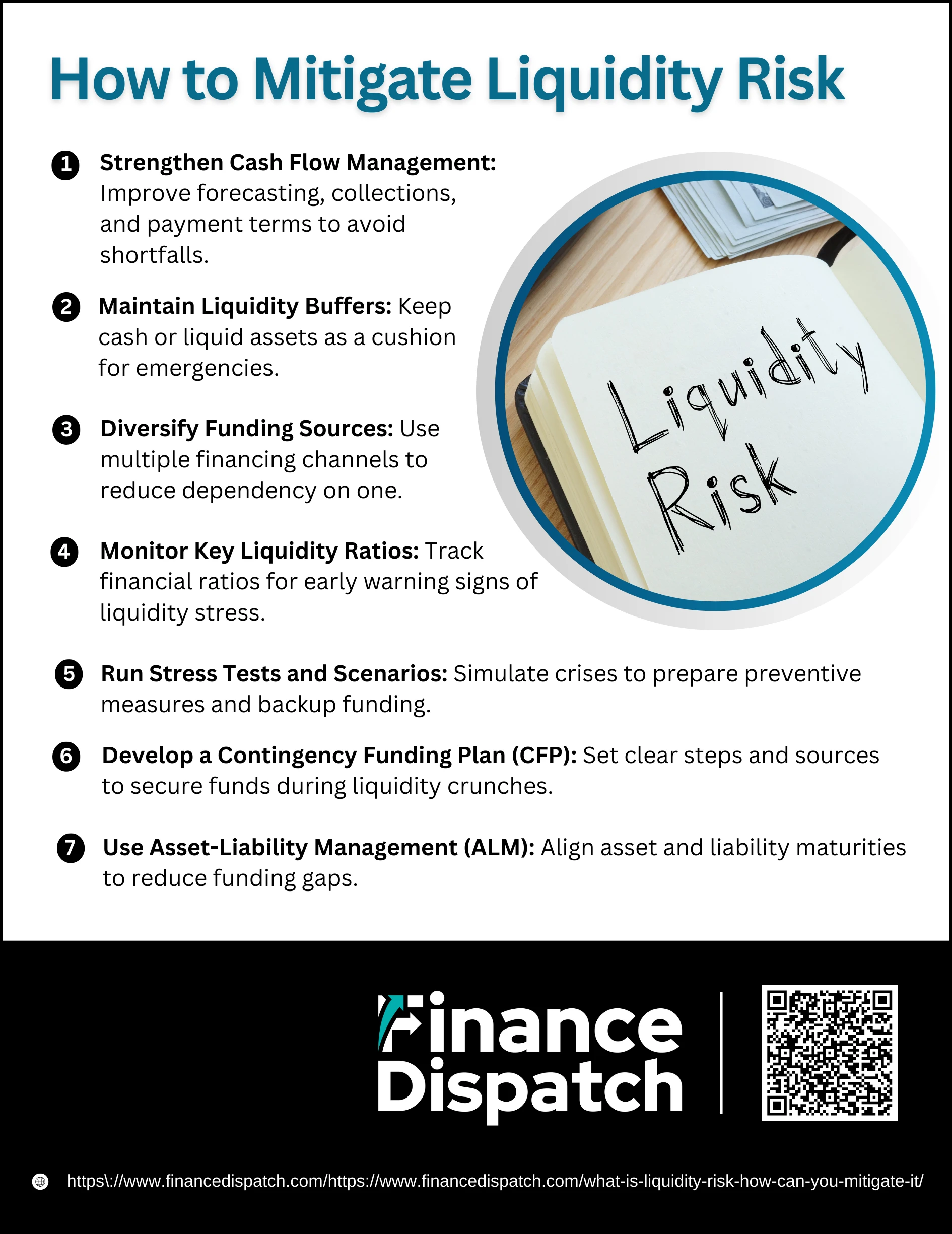Liquidity risk is one of those financial challenges that can quietly build up until it suddenly threatens the stability of a business, a bank, or even your personal finances. At its core, it’s the risk of not having enough cash—or being unable to turn assets into cash quickly enough—to cover immediate obligations like paying suppliers, servicing debt, or meeting payroll. Unlike long-term solvency issues, liquidity risk strikes in the short term and can force organizations into fire sales, higher borrowing costs, or even bankruptcy if left unchecked. In today’s volatile economic climate, where unexpected disruptions and shifting market conditions are common, understanding liquidity risk and knowing how to mitigate it is essential for financial resilience.
What is Liquidity Risk?
Liquidity risk refers to the possibility that an organization, financial institution, or even an individual will not have enough readily available cash—or cannot convert assets into cash quickly enough—to meet short-term financial obligations. This mismatch between incoming funds and outgoing liabilities often arises when assets are tied up in long-term investments or when markets lack enough buyers and sellers to allow smooth transactions. While a company may appear profitable on paper, liquidity risk can still leave it unable to pay suppliers, service debt, or cover day-to-day expenses, making it a critical factor in financial stability.
 Types of Liquidity Risk
Types of Liquidity Risk
Liquidity risk can appear in several forms, each with its own causes and consequences. Understanding these variations is essential for identifying vulnerabilities and applying the right mitigation strategies.
1. Market Liquidity Risk
This occurs when assets cannot be sold quickly at their fair market value due to limited buyers or disruptions in the market. For example, selling a large block of shares in a thinly traded stock may cause prices to fall sharply, forcing the seller to accept a loss. Market liquidity risk is especially visible during periods of financial turmoil, when investors hesitate to buy, and even valuable assets become difficult to trade.
2. Funding Liquidity Risk
Funding liquidity risk arises when an entity cannot access enough cash or external financing to meet short-term obligations. A business may face this when it relies heavily on short-term loans and lenders suddenly refuse to roll over debt. Even profitable companies can face funding difficulties if credit markets tighten or lenders lose confidence.
3. Operational Liquidity Risk
This type of risk comes from internal inefficiencies, such as poor cash flow management, delays in invoicing, or technical system failures. For instance, if a company’s billing system malfunctions, collections may be delayed, leaving insufficient cash to cover payroll or supplier payments. It highlights how day-to-day operational issues can create liquidity stress even when the business model is sound.
4. Contingent Liquidity Risk
Contingent liquidity risk emerges from unexpected events that suddenly increase the need for cash. Examples include sudden regulatory changes requiring banks to hold more liquid assets, large legal settlements, or reputational crises that cause customers to withdraw deposits. These risks are harder to predict but can quickly destabilize financial health without contingency planning.
5. Systemic Liquidity Risk
This form of risk affects the entire financial system rather than a single institution. It happens when liquidity stress spreads through interconnected markets and institutions—often seen during financial crises. For example, in 2008, the freezing of interbank lending caused even sound banks to struggle with liquidity. Systemic risk illustrates how confidence and market trust are as important as balance sheets in maintaining stability.
 How to Mitigate Liquidity Risk
How to Mitigate Liquidity Risk
Mitigating liquidity risk is about preparation, foresight, and discipline. Organizations that actively plan for cash shortfalls, diversify their funding, and build financial cushions are better equipped to withstand market disruptions or operational setbacks. Below are key strategies, explained in detail.
1. Strengthen Cash Flow Management
The foundation of liquidity risk mitigation is having clear visibility into cash inflows and outflows. Companies should conduct regular cash flow forecasting, shorten receivables cycles by improving collections, and negotiate extended but fair payment terms with suppliers. This reduces the risk of sudden gaps in liquidity and ensures day-to-day obligations can be met without stress.
2. Maintain Liquidity Buffers
Building a cushion of high-quality liquid assets (HQLA) such as cash, treasury bills, or marketable securities provides immediate access to funds in emergencies. For individuals, this translates into maintaining an emergency fund. For corporations and banks, holding liquidity reserves can be the difference between survival and insolvency during unexpected shocks.
3. Diversify Funding Sources
Relying on a single source of funding—like one bank or a handful of customers—creates vulnerability. By spreading financing across bank loans, revolving credit facilities, equity, bonds, or trade finance, companies reduce dependency and gain flexibility. This diversification improves access to funds even if one channel becomes restricted.
4. Monitor Key Liquidity Ratios
Ratios such as the current ratio, quick ratio, and cash ratio provide early warning signs of liquidity pressure. Regularly tracking these metrics allows businesses to spot deteriorating liquidity health before it turns into a crisis. For example, a declining quick ratio may indicate rising reliance on less liquid assets to meet obligations.
5. Run Stress Tests and Scenarios
Stress testing helps organizations simulate worst-case scenarios such as delayed customer payments, spikes in interest rates, or market downturns. By modeling these situations, businesses can see how liquidity would hold up and take preventive measures, such as arranging standby credit lines or adjusting their funding strategy.
6. Develop a Contingency Funding Plan (CFP)
A CFP outlines steps to take when liquidity dries up. It identifies backup funding sources—like unused credit facilities, emergency loans, or even potential asset sales—and establishes clear triggers for when the plan should be activated. This ensures a structured response during crises instead of reactive decision-making.
7. Use Asset-Liability Management (ALM)
ALM aligns the maturity of assets (e.g., long-term investments) with liabilities (e.g., short-term borrowings). By balancing these timelines, companies and banks reduce the risk of having to repay obligations without having liquid assets available. Regulatory frameworks such as Basel III emphasize ALM to strengthen resilience against funding gaps.
Liquidity Risk in Practice
In real-world situations, liquidity risk often emerges when external shocks collide with existing financial obligations. Imagine a mid-sized company that has invested heavily in expanding its operations, leaving much of its working capital tied up in long-term projects. At the same time, a sudden economic downturn slows customer payments and drives up raw material costs. With short-term debt repayments approaching, the company struggles to secure additional funding from banks, which have become cautious due to market uncertainty. To cover its obligations, it considers selling investments, but unfavorable market conditions mean doing so would trigger heavy losses. This scenario shows how quickly liquidity stress can escalate, disrupting operations, damaging reputation, and threatening overall stability—even for firms with otherwise strong business fundamentals.
How Liquidity Risk Affects Different Players
Liquidity risk is not limited to banks—it touches corporations, investors, and even individuals. Each group faces this challenge in different ways, but the common thread is the inability to quickly access cash when it’s most needed. Whether it’s a bank experiencing a sudden wave of withdrawals, a business waiting on delayed customer payments, or an individual handling unexpected expenses, liquidity risk can disrupt stability and create lasting financial consequences.
| Player | Source of Liquidity Risk | Typical Impact |
| Banks | Maturity mismatch between deposits and long-term loans; depositor withdrawals | Risk of bank runs, forced asset sales, regulatory intervention |
| Corporations | Volatile cash flows, customer payment delays, reliance on short-term debt | Operational strain, higher borrowing costs, potential insolvency |
| Investors | Illiquid assets, wide bid-ask spreads, market downturns | Forced to sell at a loss, reduced portfolio value |
| Individuals | Job loss, medical bills, reliance on credit cards or home equity | Difficulty paying bills, damaged credit, financial stress |
Measuring Liquidity Risk
Liquidity risk can only be managed if it’s measured accurately. Financial ratios and metrics give organizations insight into whether they have enough liquid resources to cover short-term obligations. Each measure highlights a different dimension of liquidity, from overall solvency to the efficiency of receivables and inventory management.
1. Current Ratio
Formula: Current Assets ÷ Current Liabilities
The current ratio provides a broad measure of short-term financial health. A ratio above 1 indicates that assets exceed liabilities, suggesting the company can cover obligations. However, too high a ratio may indicate idle assets not being used efficiently.
2. Quick Ratio (Acid Test)
Formula: (Cash + Marketable Securities + Accounts Receivable) ÷ Current Liabilities
This ratio excludes inventory, which may be difficult to liquidate quickly. It offers a more conservative view of liquidity by focusing on assets that can be readily converted into cash to meet immediate obligations.
3. Cash Ratio
Formula: (Cash + Cash Equivalents) ÷ Current Liabilities
The cash ratio is the strictest liquidity test. It examines whether a company can meet liabilities using only cash and near-cash items. While very conservative, it highlights whether the business has a sufficient safety buffer in times of crisis.
4. Operating Cash Flow Ratio
Formula: Operating Cash Flow ÷ Current Liabilities
This ratio measures the ability of ongoing operations to generate enough cash to pay debts. It’s useful because it evaluates real cash movement rather than just balance sheet items, reflecting the sustainability of operations.
5. Days Sales Outstanding (DSO)
Formula: (Accounts Receivable ÷ Total Credit Sales) × Number of Days
DSO indicates how long it takes a company to collect payments after making sales. A rising DSO suggests slower collections, signaling potential liquidity strain if cash inflows are delayed.
6. Days Payable Outstanding (DPO)
Formula: (Accounts Payable ÷ Cost of Goods Sold) × 365
DPO measures the average time a company takes to pay its suppliers. A higher DPO may improve liquidity in the short term, but stretching payments too long can damage supplier relationships.
7. Inventory Turnover Ratio
Formula: Cost of Goods Sold ÷ Average Inventory
This ratio shows how quickly inventory is sold and replaced. Low turnover suggests excess stock tying up cash, while high turnover indicates efficient use of resources and healthier liquidity.
8. Net Working Capital (NWC)
Formula: Current Assets − Current Liabilities
NWC highlights the balance between short-term assets and obligations. Positive NWC indicates liquidity strength, while negative NWC warns of potential difficulty meeting short-term commitments.
9. Debt-to-Equity Ratio
Formula: Total Liabilities ÷ Shareholders’ Equity
Although not a pure liquidity ratio, high leverage can amplify liquidity risk. Companies with large amounts of debt relative to equity may struggle to refinance obligations, especially when credit conditions tighten.
Best Practices for Ongoing Liquidity Management
Managing liquidity isn’t a one-time exercise—it requires constant monitoring and disciplined financial practices. Organizations that embed strong liquidity management into their daily operations are better prepared for unexpected shocks and more resilient during periods of market stress.
1. Regular Cash Flow Forecasting – Anticipate inflows and outflows to identify potential shortfalls early.
2. Establish a Liquidity Policy – Set clear guidelines on liquidity targets, acceptable ratios, and crisis actions.
3. Monitor Market Conditions – Stay alert to economic shifts, interest rate changes, and regulatory updates.
4. Streamline Accounts Receivable – Speed up collections through automation and early payment incentives.
5. Optimize Inventory Management – Avoid tying up cash in excess stock and reduce carrying costs.
6. Negotiate Supplier Terms – Extend payment periods strategically without harming relationships.
7. Conduct Regular Financial Reviews – Evaluate performance and cash positions to spot inefficiencies.
8. Leverage Technology for Real-Time Visibility – Use digital tools and analytics to track liquidity across accounts and scenarios.
Conclusion
Liquidity risk is a challenge that can affect banks, corporations, investors, and individuals alike, often striking when least expected. It arises from the inability to generate enough cash or convert assets quickly to meet short-term obligations, and its consequences can be severe—ranging from strained operations to insolvency. The good news is that with proactive strategies such as cash flow forecasting, maintaining liquidity buffers, diversifying funding, and stress testing, organizations and individuals can build resilience against sudden financial shocks. Ultimately, effective liquidity management is not just about survival—it’s about ensuring stability, protecting reputation, and creating the flexibility to seize opportunities even in uncertain times.



